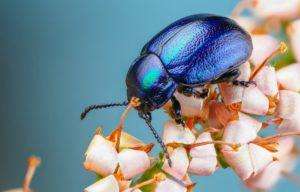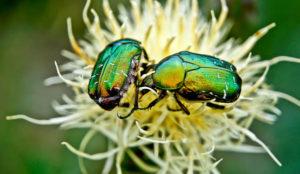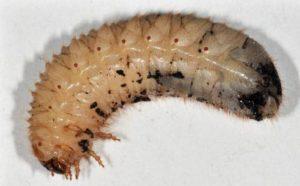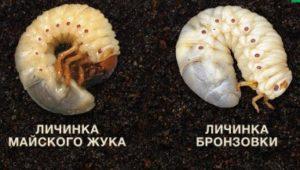What does bronze look like: a bright beetle on beautiful flowers
In gardens and orchards you can find a beetle with wings and an emerald-colored belly. Despite its beautiful color, it belongs to dangerous pests of various plants. It is worth paying special attention to the fight against him.
Content
What does the bronzovka beetle look like: photo
Description of the bronze beetle
Name: Bronze shoes
Latin:CetoniinaeClass: Insects - Insecta
Squad: Coleoptera - Coleoptera
Family: Lamellar - Scarabaeidae
 | Habitats: | garden and fields |
 | Dangerous for: | cruciferous plants |
 | Means of destruction: | naphthalene, Aktara, Decis, mechanical |

Bronze beetle.
Bronze or bronze is included in Coleoptera family. There are more than 5 varieties of this insect. The body is oval in shape. The size varies between 1,3 - 2,3 cm. The type of beetle affects the length of the body. Forelimbs of digging type.
The color of the beetle looks emerald. However, the body is black. Chitinous coating refracts light and makes it emerald metallic. In some cases, the shade may be copper red or bluish. This is optical or structural pigmentation.
The design of the wings is different from other relatives. In flight, the elytra are slightly raised. The wings are produced thanks to special cutouts in the elytra.
Bronze is often confused with green Maybug. But they have completely different lifestyles.
Habitat
The insect lives in Eurasia. Bronzovka can be found in any country on the continent. The exceptions are deserts and mountainous regions. They usually settle on flowers and bushes.
They are independent, but peaceful in nature. They can exist as several individuals in the same area and even feed on one flower.
Life cycle
Sunny warm weather is a stimulus for bronze activity. Beetles tend to move from one plant to another. Sometimes they can crash into people or animals.
Activity starts at the end of May and lasts about 4,5 months. This is affected by the region of residence. In bad weather, the beetle sits motionless. When it gets cold, it leaves the flower and lives in the ground at the roots and stems.
In June, the females lay their eggs in the ground. The eggs are yellowish white. Masonry is possible in an anthill, black soil, dunghills. After the laying process is completed, the females die.
After 14 days, white larvae appear. The diet of the larvae consists of the remains of plants and dead roots. The larvae grow up to 6 cm. After 2 molts, the body becomes yellow.
Ants are indifferent to larvae. Therefore, in winter they normally live together in an anthill. Beetles pupate in spring. By June they become adults. In summer and autumn they eat plants and flowers. They become sexually mature by the next season.
Bronze beetle diet
The beetle prefers flowers and soft ovaries. It can also eat juicy soft fruits, young shoots, leaves. Bronzovka settles in the middle of the flower and destroys the stamens and pistils.
It is worth noting the aesthetic tastes of bronze. First of all, the beetles choose elegant white and light pink flowers, and after them they can eat the rest.
After that, the flowers wither and dry up. They don't have a core. Brown spots and damaged petals appear on adult plants. There is no green plate on the leaves.
Often bronze larvae are confused with the beetle, larvae of the cockchafer. But they only look the same on the outside. In fact, bronze larvae do not harm. They feed on dead organic matter.
Prevention of the appearance of bronze
To prevent the appearance of a bronze beetle, a number of requirements must be observed.
- To carry out early plowing in the spring in connection with the wintering of larvae in the ground.
- Destroy fallen and rotted leaves, humus.
It is impossible to completely get rid of the beetle. However, timely preventive measures will reduce the number of pests.
Methods of dealing with the bronze beetle
You can attract a natural enemy - scolius wasp. Female wasps are immobilized by laying eggs. The larvae of the wasp feed on the larvae of the bronze.
One of the most common is the mechanical method. Beetles are picked by hand from the flowers early in the morning. Insects are placed in a jar of kerosene.
Chemicals
Chemicals are used in extreme cases. With a significant reproduction of the insect, insecticides can be carefully applied.
Use drugs that poison the Colorado potato beetle.
Spray the ground or inject drugs with irrigation. Processing is carried out after sunset, so that the drug begins to work. Apply:
- You decide;
- Spark;
- Lightning;
- Kinmix.
Folk methods
From folk remedies, infusions with onions, horseradish, garlic, wormwood, tansy, dandelion give a good result. The following mixtures are especially effective:
- Horse celandine (300 gr) is added to 1 liter of hot water. Insist for 2 days and spray, adding a teaspoon of grated soap;
- horse sorrel roots (30 g) are mixed with 1 liter of hot water and left for 4 hours. This solution is treated 1 time in 5 days;
- wood ash is mixed with 5 liters of water and left for 48 hours. Add 1 tbsp. a spoonful of soap and spray.
Types of bronze beetles
There are several varieties of bronze beetle. Among them there are especially interesting and unusual, which are rare.
Conclusion
Gardeners are interested in growing healthy fruits and flowers. The appearance of pests can ruin the crop. Be sure to carry out preventive measures, and when a bronze beetle appears, they begin to fight in any way.
Previous


